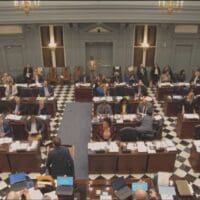If you’re dazzled by the decor in HBO’s “The Gilded Age,” you can get a taste of what was included in the Delaware Art Museum’s new Tiffany glass exhibit.
The lean, spare show lets the 60 pieces on display spread out and speak for themselves.
It also lets viewers get close enough to see the mastery of the work, which includes layered glass, embedded rocks and chunks of glass, and overlapping soldered pieces that create a depth you may never have noticed.
“Louis Comfort Tiffany: Treasures from the Driehaus Collection” opened Friday and runs through June 5.
It was meant to open in 2020, but was postponed when the COVID-19 pandemic hit, said Dr. Heather Campbell Coyle, chief curator and curator of American art. It was drawn from the massive collection of the late Richard H. Driehaus of Chicago.
The theme of the exhibit is Tiffany’s love of nature, which runs through the pieces, and their innovative approaches. Those on display include huge stained glass pieces, vases made to look like flowers and household items such as inkwells.
Louis Comfort Tiffany was the son of Charles Lewis Tiffany, who founded the famous jewelry and silver store.
Louis Comfort studied art at the National Academy of Design and went into interior design. He would go on to create rooms for many families in the Gilded Age, which was largely the 1880s as industrialization and new wealth descended on New York.
The clash of the old and new money families forms the backdrop for HBO’s “The Gilded Age,” which many people think of as America’s “Downton Abbey” because it was created by the same person, Julian Fellowes. Coyle said she’s enjoying watching it.
Tiffany’s interest in interior design led to him becoming interested in stained glass. At that time, stained glass usually was created by having color put on the outside of clear class. Tiffany became famous for embedding color into the glass before it was blown or cut into shapes.
Even then, though, artists were still required to paint the faces of people onto glass, Coyle said.
She said she didn’t realize until she was helping unpack the exhibit pieces how beautiful the metalwork of the lamp bases themselves were, because they are so often overshadowed by the showy lamp shades.
There was such a demand for Tiffany work that his glasshouse in Queens grew to include teams of people, including women, who would create pieces. They spanned the time of gas lighting and electric lighting, and many of the lampshades and bases reflect when they were created.
His work would end up in churches and other religious places as well as public spaces.
Some of Tiffany’s work would be custom-ordered for a one-of-a-kind piece. But Tiffany also had plenty of pieces that people could browse and buy off the shelf, Coyle said.
One of those made its way to Delaware.
Wilmington industrialist Samuel Bancroft and his wife, Mary, wanted a window for their home, where they were creating an interior to show off their growing art collection, which focused on the Pre-Raphaelites.
They chose a piece called Spring and Autumn and asked the studio to create a briar rose border to reflect a thicket of briar roses in their Edward Burnes-Jones’s painting “The Council House.”
Bancroft heirs donated the window to the Delaware Art Museum, where it’s often on display and now is featured as the last piece in the Tiffany exhibit. The Bancroft Pre-Raphaelite paintings became one of the Delaware Art Museum’s signature collections.
Nature shows up in the exhibit as flowers and insects visible in the familiar lamp shades and windows, but also as drooping lilies in the 18-light Lily Table Lamp, a gold Fish and Wave table lamp that evokes the feeling of Japanese prints, and the centerpiece “Landscape Window” that shows trees on a hillside.
The Geometric Window, which hints at the coming craze with abstractism in the world of art, is meant to mimic a Persian carpet. When viewed from a sharp side angle, it’s easy to see some of the techniques that Tiffany used on windows.
Tiffany Studios also produced works by outside artists, including Delaware’s Howard Pyle.
The dawn of modern style in the 1920s and the Great Depression heralded the doom of Tiffany Studios, which went bankrupt in 1932. By the mid 1900s, though, his work became popular again, with people scrambling to buy originals and companies knocking off the styles for much less.
The museum offers free tours of the exhibit at 2:15 p.m. on Sundays through June, except for Easter.
Other related events include a Pyxis Piano Trio performance March 31 featuring early 20th century music; a members’ Soiree April 1; A Spring Happy Hour Preview and lecture by Metropolitan Museum of Art Curator Alice Cooney Frelinghuysen April 29; and a Brunch at Tiffany’s May 14 that includes brunch bites and morning cocktails.
For more information, go to delart.org


Betsy Price is a Wilmington freelance writer who has 40 years of experience.
Share this Post










